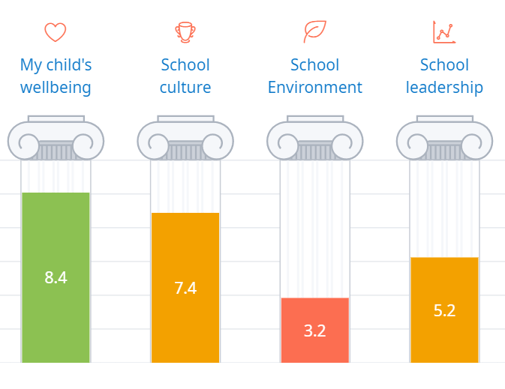Key takeaways
- School improvement plans (SIPs) are required in many US states.
- A critical aspect of a SIP is to decide which data you will need to measure in order to verify the progress of your plans.
- Using an online tool to measure, monitor, and display the right data can make this process easier.
School improvement plans, or SIPs, are commonplace in schools throughout the USA. Your state or district may call them whole-school plans, strategic plans, school development plans, or even use a different term.
School improvement plans deemed necessary throughout the country have different requirements depending on the state. Often, SIPs surround statewide goals such as assessment targets or they’ll conform to the Every Student Succeeds Act (ESSA) requirements. In approximately 37 states, schools must write improvement plans that even go beyond the federal requirements.
Ultimately, SIPs have two main features in common: they highlight the areas in which schools need to improve and they set about a plan of action to target these areas. A lot of school improvement plans often focus on both the academic results (how they’ll be improved and in which areas) and the culture and climate of the school/district.
However, attitudes toward SIPs are a mixed bag. In 2020, research showed that many educators actually doubted how useful SIPs really were: only 44% believed SIPs change teaching practices (Doss, et al.). Interestingly, 67% of school principals have the same belief. The same study showed that 62% of teachers and 81% of principals believed SIPs truly improve schools (over a period of five years). This dissonance surrounding school improvement plans shows that opinions toward them can differ and that announcing these plans to stakeholders could cause frustration.

But while this frustration can be felt in districts large or small, there are ways to streamline the action plan process. One of the best ways to ease the implementation process of a SIP is to outline which data you’ll need to track throughout the course of the plan and how you’ll share this data with the necessary stakeholders.
This blog focuses on collecting, monitoring, and sharing the culture and climate goals as part of a school improvement plan. It aims to help school leaders discern the relevant data from the irrelevant because, with the right insights and actionable next steps, school improvement plans can be a powerful tool for school staff such as principals and district leaders.
What makes a good school improvement plan?
School improvement plans must:
- use strategies that are based on scientific research
- establish benchmarks and measurements in order to prove that it’s working
- use policies most likely to improve the key areas
- use policies that ensure the progress of all students
- aim to increase parental involvement in a school
- include activities, such as after-school programs, where necessary
- include a teacher mentoring program
- include professional development for teachers
The culture & climate data to collect
The most effective school improvement plans go beyond assessment results and look at the wider picture of a young learner’s academic journey. This incorporates a school's culture and climate, for example, the general beliefs of its stakeholders, their relationships with and attitudes toward each other, and whether or not they feel respected. There are three major stakeholder groups regarding culture and climate data: students, staff, and parents. Below you will find the specific data you should seek out from each group and why this is important.
In 2020, research showed that many educators actually doubted how useful SIPs really were: only 44% believed SIPs change teaching practices (Doss, et al.).
Students
Students are the group of stakeholders that school improvement plans are most likely to concentrate on. Usually, they will concern academic results on a statewide level, but a good school improvement plan will also consider their wellbeing and safety. This is important because positive learning environments are linked to higher success rates for students (Henderson; Mapp. 2022).
Data you could consider collecting from students include:
- Health and wellbeing
- Feelings toward school
- Feelings toward their education
- Relationships with other students
- Relationships with teachers
- Reward and recognition
- School culture
Using a holistic platform to seek out student culture and climate data is also helpful because it ensures you are working to improve the wellbeing and academic outcomes of all students - an imperative feature of a SIP (see above section). They also make it easier to establish the necessary benchmarks you will need in order to verify the progress of your plans since the data collection is automated and automatically updated on your dashboards.
Learn more: Climate
-png.png?width=543&height=379&name=unnamed%20(1)-png.png)
Examples of Satchel Pulse’s Student Culture & Climate Pillars
Staff
Oftentimes, staff wellbeing will be included in school improvement plans because it has a strong impact on other aspects of a school district, such as student achievement. To make improvements in many areas, measuring staff insights will help you take steps toward reaching these goals.
For example, if your school is aiming to improve student attendance, measuring how happy your staff are with their job and whether or not they find their work meaningful can give you the ideal insights into your schools’ work environment. This is because young learners are typically directly affected by a staff member’s (for example, a teacher’s) wellbeing since they’re in direct contact with them regularly.
Young learners are likely to be able to sense whether a teacher truly cares about their learning and if they feel motivated to do their job. In the end, this is probably going to play a role in truancy issues (particularly among older students), behavioral problems in the classroom, and academic results.
Additionally, a school’s improvement plan could have a target directly related to staff wellbeing, for example to improve job satisfaction rates by X% by the end of the term. Using a good culture and climate tool, such as Satchel Pulse's Climate, will give you the data you need to quantify these targets - so you can easily put a number to the plans you’re putting in place.
Regarding school staff, our culture and climate tool measures:
- Appreciation & recognition
- Career development
- Culture fit
- Job satisfaction
- Meaningful work
- Relationship with colleagues
- Relationship with supervisor
- School management
-png.png?width=513&height=362&name=unnamed%20(2)-png.png)
Examples of Satchel Pulse's Staff Culture & Climate Pillars
Parents
Since school improvement plans should also aim to increase parental involvement in their children’s education, monitoring their satisfaction and feelings over time can also help to create a successful SIP. You could use data on parents, caregivers, and families to demonstrate how your parental involvement plans have impacted their happiness with your school.
Our Solution gives the following parental insights regarding:
- Communication with the school
- Their child’s learning
- Their child’s wellbeing
- Their child’s safety
- School culture
- School environment
- School leadership
- Teaching staff
Examples of Satchel Pulse's Staff Culture & Climate Pillars
Another way you could use this data to reflect on your SIP success is to demonstrate the impact of goals surrounding communication improvement plans (use the Communication with the School Pillar), measures taken to improve school safety (use the My Child’s Safety Pillar), or steps taken to improve staff wellbeing (use the Teaching Staff/School Leadership Pillars).
The data you’ll need for a school improvement plan can vary, but you should always follow your state’s requirements. Measuring culture and climate data can make SIPs even more powerful tools for superintendents, school principals, district leaders, or any other district staff member responsible for seeing them through. Consider using a holistic, online solution for your culture and climate data needs - ideally choose one that can automatically seek out the data, display it on a dashboard, and give guidance on how to act on it.
References:
50-State Comparison: States’ School Improvement Policies. (2022). Education Commission of the States. Read it here.
Every Students Succeeds Act. Read more here.
A New Wave of Evidence: The Impact of School, Family, and Community Connections on Student Achievement. (2002). Henderson, A.T. & Mapp, K. L. Read it here.
School improvement plans: Is there room for improvement? (2020). Doss, C.J., Akinniranye, G., and Tosh, K. RAND Corporation. Read it here.
Author: Fern Dinsdale
Posted: 10 Oct 2022
Estimated time to read: 9 mins
